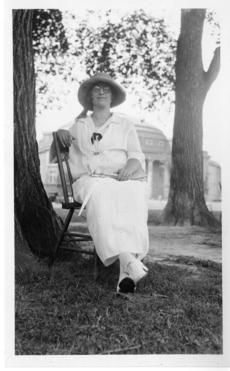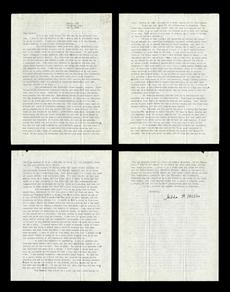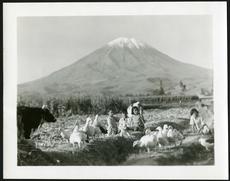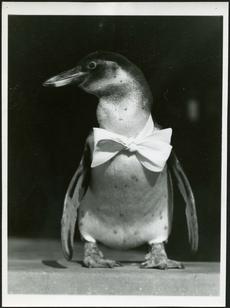 As an archival student and volunteer, I have been very fortunate to be able to work with the collections at the Smithsonian Institution Archives. My favorite project so far has been the rehousing and cataloging of the Watson Davis Papers (Accession 13-197, Smithsonian Institution Archives). This collection serves as a fascinating kaleidoscope of scientific information as well as a window into the lives of his many friends and colleagues. I would like to share with you the story of one particular woman who corresponded a great deal with Watson Davis and his wife, Helen Miles Davis, as she journeyed into the wilds of Peru in pursuit of her scientific career.
As an archival student and volunteer, I have been very fortunate to be able to work with the collections at the Smithsonian Institution Archives. My favorite project so far has been the rehousing and cataloging of the Watson Davis Papers (Accession 13-197, Smithsonian Institution Archives). This collection serves as a fascinating kaleidoscope of scientific information as well as a window into the lives of his many friends and colleagues. I would like to share with you the story of one particular woman who corresponded a great deal with Watson Davis and his wife, Helen Miles Davis, as she journeyed into the wilds of Peru in pursuit of her scientific career.
 Hilda Hempl Heller, being one of the few female scientists of the time, lived and worked with much enthusiasm and aplomb, characteristics she shared with the Davis’ and the Science Service community. Her story inspired me because despite the limited access women had to higher education and the scientific field at the time, Heller succeeded and excelled in both. She did not subscribe to the societal norms of what a woman's role should be, but rather forged her own path. Heller is an exceptional example of a person who did not merely see life as it should be, but instead was a person who saw that life held enormous possibilities so long as you were open to the challenge.
Hilda Hempl Heller, being one of the few female scientists of the time, lived and worked with much enthusiasm and aplomb, characteristics she shared with the Davis’ and the Science Service community. Her story inspired me because despite the limited access women had to higher education and the scientific field at the time, Heller succeeded and excelled in both. She did not subscribe to the societal norms of what a woman's role should be, but rather forged her own path. Heller is an exceptional example of a person who did not merely see life as it should be, but instead was a person who saw that life held enormous possibilities so long as you were open to the challenge.
According to her unpublished autobiography found in the Watson Davis Papers, Hilda Hempl Heller was born in 1891 in Ann Arbor, Michigan, to George Hempl, a professor of philosophy. She studied biology at Stanford University, with a focus on zoology and bacteriology. She went on to study at the University of Michigan, where she spent two years during World War I, traveling as a research fellow in Copenhagen, London, Algiers, and Paris, and finally got her doctorate in 1920 under Dr. Karl F. Meyer at the University of California.
 In 1918, she married Edmund Heller, a prolific naturalist who was made famous working as the field scientist for Colonel Theodore Roosevelt on his hunting expeditions throughout Africa and various parts of the world. Between 1921 and 1926, Heller accompanied her husband three times on these expeditions where she participated in the study of the big game animals of Yellowstone Park, a mammal collecting expedition to central Peru, and down the Amazon River. After divorcing her husband in 1949 1928, she went on to pursue her own career by conducting field research in anthropology and natural history by returning to the wilderness of Peru. Her fond letters to Davis and his wife, Helen, detail the triumphs and failures she experienced while on her adventures, including the life and death of a peculiar residential penguin by the name of Poncho.
In 1918, she married Edmund Heller, a prolific naturalist who was made famous working as the field scientist for Colonel Theodore Roosevelt on his hunting expeditions throughout Africa and various parts of the world. Between 1921 and 1926, Heller accompanied her husband three times on these expeditions where she participated in the study of the big game animals of Yellowstone Park, a mammal collecting expedition to central Peru, and down the Amazon River. After divorcing her husband in 1949 1928, she went on to pursue her own career by conducting field research in anthropology and natural history by returning to the wilderness of Peru. Her fond letters to Davis and his wife, Helen, detail the triumphs and failures she experienced while on her adventures, including the life and death of a peculiar residential penguin by the name of Poncho.

Hilda Hempl Heller, a woman possessed of a charming, vivacious personality and intelligence, challenged the stereotypical idea of a woman’s role in society during her lifetime. However, the research and field books she may have kept are not at the Smithsonian alongside those created by her husband. It may be that they are being processed or stored at another location. At this time, it is difficult to find information on this amazing woman outside of the Watson Davis Papers. There is a photograph collection at The Field Museum in Chicago, which contains images from her fieldwork and her husband's expeditions. Regardless of whether or not she was formally recognized for her contributions to the scientific field in her lifetime, Heller was a unique character who refused to live by the social status quo, and serves as an inspiration for women today and for future generations.
Related Resources
- Women in Science, Smithsonian Institution Archives
- There Are Prizes . . . and There Are Winners, The Bigger Picture blog, Smithsonian Institution Archives
- Where are Heller's Field Books, Field Book Project blog, National Museum of Natural History/Smithsonian Institution Archives
Related Collections
- Record Unit 7179 - Edmund Heller Papers, circa 1898-1918, Smithsonian Institution Archives
Produced by the Smithsonian Institution Archives. For copyright questions, please see the Terms of Use.

Leave a Comment